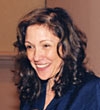Ann Druyan is an author, lecturer and TV and motion picture writer/producer whose work is largely concerned with the effects of science and technology on our society. She co-wrote the Emmy and Peabody award-winning TV series “Cosmos,” viewed by half a billion in over 60 countries, which was the most widely watched series in the history of American public television. She served as creative director of the NASA Voyager Interstellar Record Project affixed to the Voyager I and II spacecraft.
She coauthored, with her late husband Carl Sagan, several books, including: Comet, on The New York Times bestseller list for two months, Shadows of Forgotten Ancestors, another bestseller, and is a credited contributor to Sagan’s bestselling books Contact, Pale Blue Dot, The Demon-Haunted World and Billions and Billions. Her articles have appeared in the New York Times Sunday Magazine, Reader’s Digest, Parade, Discover, and The Washington Post.
Ann Druyan is president of Hypatia Productions, Inc., has been a peace activist, organizing three of the largest nonviolent demonstrations ever held at the Nevada nuclear test site, and has been involved in international monitoring of underground nuclear testing. Since 1988, she has served as Secretary of the Federation of American Scientists, known as the “conscience of American science.” She is also a director of the Children’s Health Fund, providing mobile pediatric care to disadvantaged children in several cities.
She is co-producer and co-creator of the Warner Brothers’ motion picture “Contact,” which featured an atheist-scientist heroine starring Jodie Foster, and includes a cameo by Ann Druyan. She was producer and screen writer of a 3-D IMAX motion picture for Sony Pictures called “Comet.”
She was married to her long-time collaborator, astronomer Carl Sagan, until his death in December of 1996. Their children are Alexandra, born in 1982, and Sam, born in 1991. She wrote the epilogue for Carl Sagan’s final book Billions and Billions: Thoughts on Life and Death at the Brink of the Millennium, which was published posthumously in 1997.
In the epilogue, Ann Druyan wrote:
“Contrary to the fantasies of the fundamentalists, there was no deathbed conversion, no last-minute refuge taken in a comforting vision of a heaven or an afterlife. For Carl, what mattered most was what was true, not merely what would make us feel better.”
She also wrote that many people had written to say that Carl’s example has inspired them “to work for science and reason, against the forces of superstition and fundamentalism. These thoughts comfort me and lift me up out of my heartache,” she wrote. “They allow me to feel, without resorting to the supernatural, that Carl lives.”
“We wish not only to recognize Annie Druyan’s impressive achievements, but also to salute her for defending Carl Sagan’s memory and reputation from the ignominy of talk of a deathbed conversion, and we applaud her commitment to reason over superstition,” said Annie Laurie Gaylor on behalf of the Foundation in awarding Ann Druyan a plaque naming her “1997 Freethought Heroine.”


